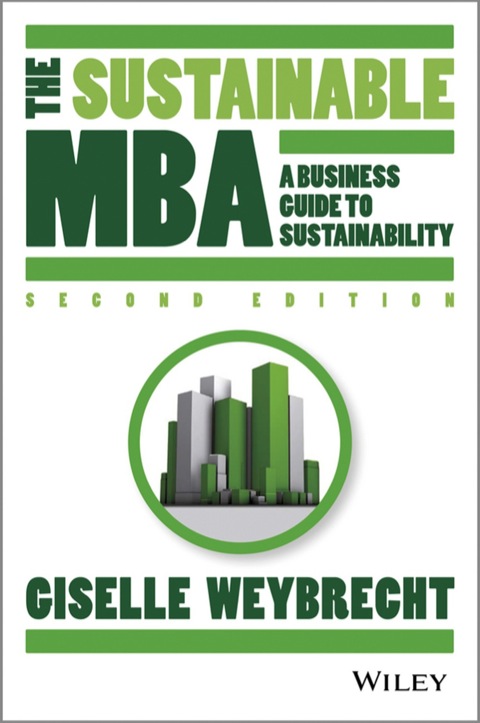Description
Efnisyfirlit
- The Sustainable MBA: A Business Guide to Sustainability
- Copyright
- Contents
- Preface
- Acknowledgments
- Part 1: Setting the Scene
- Chapter 1: About this Book
- Who is The Sustainable MBA for and why should I read it?
- What you will find in The Sustainable MBA
- How The Sustainable MBA is organized
- Ideas on how to use this book
- Planet Earth fact sheet
- Chapter 2: What is Sustainability?
- The basics
- Other definitions
- Sustainable development: A global effort
- Working together: Stakeholders in sustainability
- Chapter 3: What does this Mean for Business?
- The business case
- The sustainability sales pitch
- Chapter 4: The Sustainability Journey
- The journey
- What does a leading company look like?
- Chapter 5: Getting Started
- Step by step
- Getting past internal excuses
- Part 2: The Core Topics
- Chapter 6: Accounting
- Why is it important?
- The key concepts
- Full or true cost accounting
- Materiality
- Key performance indicators
- Measuring social impact
- Sustainability in financial statements
- Integrated reporting
- Assurance
- Challenges?
- Trends and new ideas
- Bringing it all together
- Increased disclosure
- Recognizing unrecognized assets
- Different forms of reporting
- Shadow reporting
- Sustainability reporting
- Chapter 7: Economics
- Why is it important?
- The key concepts
- Sustainable consumption
- The commons
- Externalities
- Market-based incentives
- Re-evaluating GDP
- Emerging markets
- Challenges?
- Trends and new ideas
- Alternative trading systems
- A new economic model
- Estimating the cost of inaction
- From free to fee
- Valuing future generations
- Regulatory instruments
- Environmental valuation
- Business and the world’s poor
- Chapter 8: Entrepreneurship
- Why is it important?
- The key concepts
- Social/environmental entrepreneurs
- Exploring new business models
- Making changes from within
- Generating ideas
- Funding
- Challenges?
- Trends and new ideas
- Merging and selling
- Microbusinesses
- Social stock exchange
- Working with big business
- Marketing on a shoestring
- Some advice for entrepreneurs
- Cooperatives
- Chapter 9: Ethics and Corporate Governance
- Why is it important?
- The key concepts
- Business and human rights
- Labor and working conditions
- Ethics and the individual manager
- Corporate governance
- Corruption
- Bribery
- The power of media
- Challenges?
- Trends and new ideas
- Transparency and honesty
- The company of the future
- Fair trade
- Crowdsourcing the truth
- Whistleblowing
- The role of the CEO
- Chapter 10: Finance
- Why is it important?
- The key concepts
- Sustainable investment
- Integrating ESG
- Fiduciary responsibilities
- Shareholder engagement
- Ratings and indexes
- Project finance
- Challenges?
- Trends and new ideas
- Cross-disciplinary collaboration
- New landscape for corporate ownership
- Long-term value
- The role of the CFO
- Insurance sector
- A new kind of bank
- Microfinance
- Chapter 11: Marketing
- Why is it important?
- The key concepts
- People
- Products
- Price
- Place
- Packaging
- Eco-labels
- Social marketing
- Cause-related marketing
- Challenges?
- Trends and new ideas
- Green = inexpensive
- Eco-iconic to eco-embedded
- Understanding how people think
- Communicating with the customer virtually
- Popups
- Buycotts
- The barcode reinvented
- Advertising dos and don’ts
- Chapter 12: Operations
- Why is it important?
- The key concepts
- Eco-design
- ‘Green’ chemistry
- Doing more with less
- Sustainable technology
- Suppliers and contractors
- Transportation
- Waste management
- Challenges?
- Trends and new ideas
- Inspiration from nature
- Products that do more
- Traceability
- Manufacturing differently
- Instant feedback
- Exploring new materials
- Co-creation
- Lifecycle assessment
- Information technology/information systems
- Chapter 13: HR and Organizational Behavior
- Why is it important?
- The key concepts
- Creating a culture of sustainability
- Communication
- Recruiting
- Employee engagement
- Motivation and rewards
- Talent development and training
- Challenges?
- Trends and new ideas
- Linking pay and sustainability
- Diversity
- Skills for sustainability
- Creating great workplaces
- Changing the way we talk
- Rise of the CSO
- Managing change
- Chapter 14: Strategy
- Why is it important?
- The key concepts
- The wider business environment
- Understanding where you stand
- Understanding risks
- Sustainability strategies
- Goals and targets
- Working with others
- Influencing change
- Challenges?
- Trends and new ideas
- Zero and 100%
- Getting your customers involved
- Instant information
- Strategic philanthropy
- Transformation of partners
- Why do initiatives fail?
- Stakeholder engagement
- Part 3: Tools
- Chapter 15: Tools for Monitoring, Managing, and Improving Performance
- Assessments
- Audits
- Environmental and social management systems
- Standards
- Chapter 16: Tools for Greening Offices and Buildings
- Steps for setting up office greening programs
- Buildings
- Energy
- Water
- Waste and recycling
- Paper
- Electronics
- All those other little things
- Commuting to work
- Organizing green events and meetings
- Putting together a green team
- Performance contracting
- Part 4: Wrapping It All Up
- Chapter 17: What Can I Do?
- As an employee – leading by example
- How to turn any job into a green job
- As a consumer – putting your money where your mouth is
- A simple guide to making choices as a consumer
- As a citizen – be active in your community
- Chapter 18: What Will the Future Bring?
- Twenty-one wise words of advice
- Additional Resources: Who, What, Where, and How
- Who: Different groups involved in sustainability
- What: Sustainability issues
- Where: Sustainability around the world
- How: Keeping up to date
- Endnotes
- Index






Reviews
There are no reviews yet.